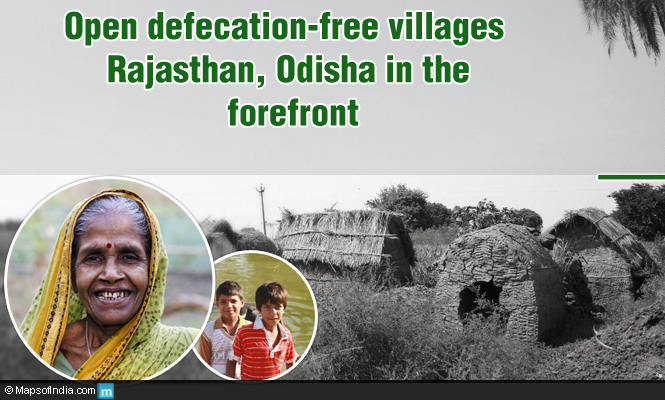According to a recent report by UNICEF, more than half of India’s population defecates in the open, and the situation is worse in the acutely impoverished rural areas. Prime Minister Narendra Modi launched Swachh Bharat Abhiyan on October 2, 2014 with the aim of making India open defecation free (ODF) by 2019. The objective is to provide every village and every person in India, toilet and sanitation facilities, including solid and liquid waste disposal systems, safe and adequate drinking water supply and cleanliness of villages, towns and cities.
Some recent successes in Swachh Bharat Abhiyan
Rajasthan : Seven tribal villages of the State are now open defecation free. It has been reported that 60% of the population of the State of Rajasthan defecates in the open. The southern part of the State is dominated by the socio-economically backward classes of people as well as the tribals. In fact, Rajasthan ranks among the bottom five States in India for open defecation. But, it is heartening to see major changes taking place in south Rajasthan. Seven villages in the districts of Chittorgarh, Udaipur and Bhilwara have become open defecation free (ODF). These are Maton, Rela, Nevatalai, Chanawda, Dabok villages in Udaipur, Bansen village in Chittorgarh, and Parasrampura village in Bhilwara. Ten thousand households have given up the traditional habit of defecating in the open after the construction of pucca toilets at their homes. The villagers needed lot of counselling and pleading for the construction and use of toilets as they had the habit of relieving themselves in the open. They were poor and it was difficult to save money required to build their individual toilets. But, now these seven villages are proud of their achievement.
This achievement was due to the initiative taken by the State Government and Hindustan Zinc of the Vedanta Group under the project ‘Maryada’. Maryada was launched with an aim to make 80 villages of Rajasthan ‘open defecation free. However, this was a part of the Nirmal Bharat Abhiyan. Now, with the launch of the Swachh Bharat Abhiyan, Hindustan Zinc and the Rajasthan Government will continue to take forward this cleanliness drive by constructing all together 30,000 toilets (10,000 already completed) and make Rajasthan an open defecation free State by 2019. The project also aims at bringing behavioural changes among the people.
Churu district in Rajasthan: One of the most backward States in India in terms of open defecation, Rajasthan has led the way for others because Churu district is likely to become the first district in the State to get the defecation free status very soon. Most of the blocks in the district has already achieved or near its achievement of the 100% target of providing toilets in each household. Although the pace had slowed down due to the recent State Assembly and Lok Sabha elections, the local administration is now ensuring to start it once again in full swing and achieve the defecation free target by the end of this year. A campaign ‘Chokho Churu’ was initiated by the District administration where emphasis was on community mobilization. Public meetings, night village meetings or ratri chaupals and other awareness programmes were carried out. And it was because these programmes, most people’s mindsets changed and they realised the various ill effects related to open defecation. As a result, people became more eager to construct toilets themselves, with the help of the Government. Churu’s performance should be an eye-opener for other villages as well.
Eleven villages in Koraput district in Odisha: Koraput in Odisha is supposed to be one of the most-backward districts of India. However, 11 villages of Koraput and Semiliguda blocks in the Koraput district have become open defecation free villages as 522 households of these villages have started using pucca toilets constructed at their houses. It is really very heartening to see that this district dominated by the tribal people has set an example for others to follow. And, now there is strict prohibition on open defecation in the district. These ODF 11 villages are Chandrmundar, Gandhiput, Station Suku, Chakarliguda, Khaparaput, Haldiput, Maliguda of Koraput block and Doraguda, Jagamput, Bandguda, and Sadam of Semiliguda.
Initially the response of the villagers to construct toilets was negative. A series of awareness campaigns in the form of street plays, posters and pictorial presentations by the district administration made the people conscious about the hazards of open defecation. It was the under the campaign Nirmal Bharat Abhiyan, construction of toilets was started with an estimated cost of Rs 10,000 each. It continued under the Swachh Bharat Abhiyan. Rs 4,500 was provided through Mahatma Gandhi National Rural Employment Guarantee Act (MGNREGA) and Rs 4,600 by the District Water and Sanitation Mission (DWSM). Each individual household contributed Rs 900.
The ODF villages of Koraput district are a encouragement for other neighbouring villages to use toilets. According to a statement by an executive engineer of rural water supply and sanitation, Koraput, at least three villages each of 14 blocks in the district Koraput will become open defecation free by March 2015.
Himachal Pradesh to be first State to become ODF by 2019: The Himachal Pradesh State Government is determined to obtain the target of 100% ODF tag before 2019. Under the Swachh Bharat Abhiyan, Rs 852.55 cr has been approved for revised projects, out of which, Rs 48 crore has already been received. The construction of toilets started with the Nirmal Bharat Abhiyan will continue with the Swachh Bharat Abhiyan. According to a survey report, till early 2013, out of 14 lakh households in the State, around 12 lakh households have already the toilets facility. So covering the remaining 2.2 lakh toilets won’t be difficult by 2019. Out of a total of 2.2 lakh individual toilets, 54,000 toilets have already been constructed, and 1,200 toilets are under near completion in the schools.
This is indeed a challenging task which involves the participation of not only the Government, NGOs, corporates or celebrities, but also the involvement of the general public as a whole. Ending open defecation by 2019 requires changing minds. Allocating money to construct toilets for people is not enough, unless and until people actually start developing the habit to use them and remain clean themselves. Certainly there are going to be many more success stories.
Read more :
MUDRA Bank : Details, objectives and benefits
Swachh Bharat Abhiyan: Making India Clean & More
Swachh Bharat Abhiyan: Bal Swachhata Abhiyan
Swachh Bharat Abhiyan: Modi Launches Cleanliness Campaign
Swachh Bharat Abhiyan: Cleanathon Campaign by NDTV India, Dettol
Swachh Bharat Abhiyan: The Celebrity Chain for Cleanliness Continues
Swachh Bharat Abhiyan in Full Swing in States
Swachhta Entrepreneurs – An Operative Wing for Swachh Bharat Abhiyan
Swachh Bharat Abhiyan: A Stage-managed Cleanliness Operation in Delhi?
Swachh Bharat Abhiyan: Celebrities and Politicians Join Hands
100 hours every year to cleanliness for Swachh Bharat – A mission to Clean India
Swachh Bharat Abhiyan: India Observes World Toilet Day
Clean India Campaign – Some Lessons from Other Countries
Swachh Bharat: You and Your Dog, Who Will Scoop the Poop?
Swachh Bharat Abhiyan: Will It Help Reduce the Incidence of Communicable Diseases?
Swachh Bharat Abhiyan: Then Why Do We Pay for 50,000 Sweepers in a City?
Swachh Bharat Abhiyan: Can We Follow a Green Diwali This Year?






